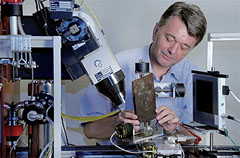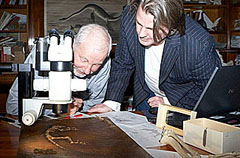Ida was first described scientifically in the article "Complete primate skeleton from the middle Eocene of Messel in Germany: morphology and paleobiology". The article was published on May 19th 2009 in PLoS One, an internet-based scientific journal which is so-called "open access". In contrast to many scientific articles which are published in expensive and prestigious subscription journals, the article about Ida could be read by anyone with access to the internet the minute it was published.
The authors were the group of scientists who had had access to Ida for two years before she was made known to the world at large. Jørn had given them the rather tongue-in-cheek name "The Dream Team":
- Dr. Jens Lorenz Franzen, The Senckenberg Research Institute in Frankfurt and The Natural History Museum in Basel
- Professor Philip Gingerich, The Paleontological Museum and The Geo-Institute of The University of Michigan
- Dr. Jörg Habersetzer, The Senckenberg Research Institute
- Dr. Jørn Hurum, The Natural History Museum of The University of Oslo
- Professor Wighart von Koenigswald, The Steinmann Institute of Geology, Mineralogy and Paleontology, The University of Bonn
- Dr Holly Smith, The Anthropological Museum, University of Michigan
Their research results was subjected to the usual the ordinary peer reviews before publishing. The publication was thoroughly planned to coincide with the launching of the film, the book and the website. In this way, everyone was given instant and simultaneous access to the scientific results.
By means of CT-scanning and X-ray photographs, the scientists have studied both the exterior and the interior of the fossil. This has, for example, made it possible for them to determine the number of milk teeth in her jaw.
Scientific articles on Ida
- Jens L. Franzen, Philip D. Gingerich, Jörg Habersetzer, Jørn H. Hurum, Wighart von Koenigswald, B. Holly Smith:
Complete Primate Skeleton from the Middle Eocene of Messel in Germany: Morphology and Paleobiology (PLoS ONE, 2009) - Blythe A. Williams, Richard F. Kay, E. Christopher Kirk, Callum F. Ross:
Darwinius masillae is a strepsirrhine – a reply to Franzen et al. (2009) (pdf, Journal of Human Evolution, 2010) - Philip D. Gingerich, Jens L. Franzen, Jörg Habersetzer, Jørn H. Hurum and B. Holly Smith:
Darwinius masillae is a Haplorhine — Reply to Williams et al. (2010) (Journal of Human Evolution, 2010)
 CT-scan of Ida’s skull, almost unprocessed on the left, processed on the right. We can just recognize details of the skull’s shape in the two images. Photo: Jörg Habersetzer, The Senckenberg Institute |
 The molars, stained blue on the left, enlarged at right. Photo: Jörg Habersetzer, The Senckenberg Institute |
 Jörg Habersetzer studying Europolemur koenigswaldi through the CT-microscope. Europolemur is one of Ida’s relatives found in Messel. Photo: S. Tränkner, The Senckenberg Institute |
 Jens L. Franzen and Jørn H. Hurum studying Ida in Hurum’s office at the Natural History Museum in Oslo. Photo: Atlantic Productions |